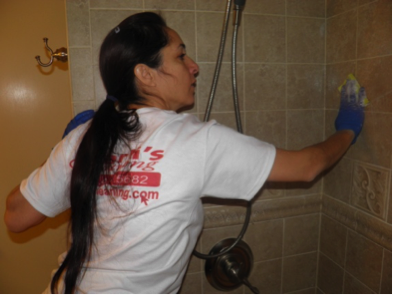A house should be cleaned in the most gentle way. You should take that into consideration. More TIPS below:
![]() The cleaning rag should be used in one house and one house only.
The cleaning rag should be used in one house and one house only.
![]() The type of product used should be as gentle as possible.
The type of product used should be as gentle as possible.
![]() House Cleaners should carefully move furniture (use special protectors) to prevent floors from being scratched.
House Cleaners should carefully move furniture (use special protectors) to prevent floors from being scratched.
![]() Vacuums should have HEPA(High EfficiencyParticulate Air) filters. The best possible, otherwise the whole house will be contaminated with allergens afterwards.
Vacuums should have HEPA(High EfficiencyParticulate Air) filters. The best possible, otherwise the whole house will be contaminated with allergens afterwards.
HEPA filters, by definition, remove at least 99.97% of airborne particles 0.3 micrometers (µm) in diameter.
HEPA filters are composed of a mat of randomly arranged fibres. The fibres are typical composed of fiberglass and possess diameters between 0.5 and 2.0 micron. Key metrics affecting function are fibre diameter, filter thickness, and face velocity. The air space between HEPA filter fibres is much greater than 0.3 μm. The common assumption that a HEPA filter acts like a sieve where particles smaller than the largest opening can pass through is incorrect. Unlike membrane filters, where particles as wide as the largest opening or distance between fibres cannot pass in between them at all, HEPA filters are designed to target much smaller pollutants and particles. These particles are trapped (they stick to a fibre) through a combination of the following three mechanisms:
- Interception, where particles following a line of flow in the air stream come within one radius of a fibre and adhere to it.
- Impaction, where larger particles are unable to avoid fibres by following the curving contours of the air stream and are forced to embed in one of them directly; this effect increases with diminishing fibre separation and higher air flow velocity.
- Diffusion, an enhancing mechanism is a result of the collision with gas molecules by the smallest particles, especially those below 0.1 µm in diameter, which are thereby impeded and delayed in their path through the filter; this behaviour is similar to Brownian motion and raises the probability that a particle will be stopped by either of the two mechanisms above; it becomes dominant at lower air flow velocities.
Diffusion predominates below the 0.1 μm diameter particle size. Impaction and interception predominate above 0.4 μm. In between, near the 0.3 μm MPPS, diffusion and interception predominate.
The filter resistance to flow is known as its pressure drop.




